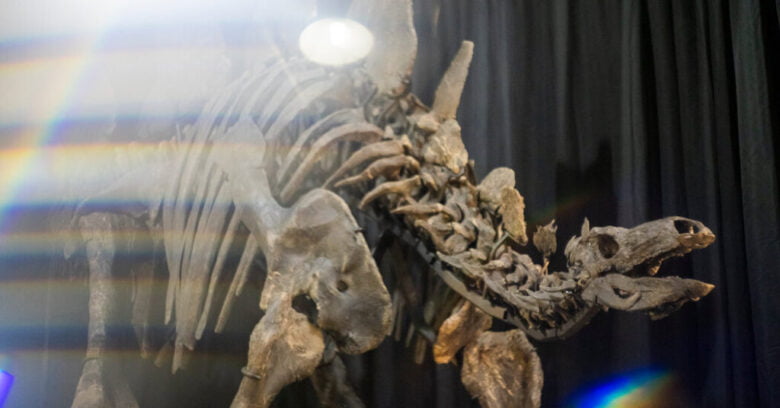In May 2022, Jason Cooper, a commercial paleontologist, was hiking with a friend on his property near the aptly named Dinosaur City, Colorado, and found a piece of femur sticking out of some rock.
This femur led to a Stegosaurus fossil, one of the largest and most complete ever found, and subsequently nicknamed “Apex”. In July, Sotheby’s will sell the Apex at auction for an estimated $4 million to $6 million, making the skeleton the latest flashpoint in the long-running debate over private fossil trade.
Since 1997, when Sotheby’s sold Tyrannosaurus rex “Sue” to the Field Museum in Chicago for $8.36 million, dinosaur fossils have fetched escalating prices at auction houses. In 2020, “Stan”, another largely complete T. rex skeleton, sold at Christie’s for $31.8 million.
Such awards have raised serious concerns among academic paleontologists, said Stuart Sumida, vice president of the Society of Vertebrate Paleontology. Many of them have watched fossils that can unlock scientific secrets fall into the hands of wealthy private collectors rather than research institutions in recent decades.
Mr. Cooper and his colleagues discovered the stegosaurus at Sotheby’s in 2023. Excavations on his property yielded a number of dinosaurs from the Jurassic period, several of which Mr. Cooper donated to institutions such as the Brigham Young University Museum of Paleontology in Provo, Utah. and the Frost Museum of Science in Miami.
Mr Cooper described the Stegosaurus Apex as a unique and scientifically significant specimen. Skeletons – even partial ones – of spike-tailed herbivores are rare. The skeleton holder contains material from about 70 percent of the animal’s bones. At 11 feet tall and over 20 feet long, Apex is twice the size of “Sophie,” the most intact stegosaurus specimen known, and has unusual proportions, remarkably long legs, and square bottom plates.
The specimen was also discovered with skin impressions, possibly from the neck, which will be offered as part of the sale.
Mr Cooper oversaw the preparation and assembly of the stegosaurus, 3D scanning the existing bones and mirroring the specimen elements to fill in the gaps. The team also collected extensive contextual data that they believe could be attractive to potential buyers. The information includes a detailed site survey, quarry maps and other documentation
Mr. Cooper also invited several paleontologists to examine the specimen.
“If you combine the size, the completeness and the preservation of the bones, it’s the best stegosaurus I’ve seen,” said Rod Scheetz, curator of the Brigham Young University Museum of Paleontology, who viewed it on Mr. Cooper’s property.
Cassandra Hatton, head of science and popular culture at Sotheby’s, said the auction house had worked closely with Mr Cooper to strengthen the scientific legitimacy of the privately sold dinosaur horse to create a model for future auctions.
“This is the first time a specimen has been auctioned, where we have worked together since it was excavated,” she said. “This is the most transparent sale of a dinosaur ever.”
But Jim Kirkland, Utah’s state paleontologist, refused to endorse a stegosaurus when invited by Mr. Cooper. “It looks pretty interesting,” he wrote in an email, “but I’m not going to promote anything that’s going to auction. I would associate it directly with museums, but not this one.”
While anything can happen at public auction, both Mr. Cooper and Ms. Hatton expressed their hope that the Apex will eventually land with a scientific institution — either through outright purchase or a gift from a private collector. The team gathered data and documentation not only to reassure potential buyers of the specimens’ authenticity, but also to help museums seamlessly integrate such a specimen into a research collection.
“Whoever buys it also has the right to come onto my property and collect contextual information,” Mr Cooper said. “A private collector might not give a hoot about it, but it would be really cool for a museum.”
However, the potential cost of a stegosaurus could be out of reach for many institutions, said Dr. Sumida. He stated that the cost of studying an already mounted and reconstructed specimen can be higher than just the purchase price. Reconstructing and mounting fossils is as much art as science—and particular choices can be used to fool the uninitiated by blurring the lines about which parts of a given bone are real.
“If the sample is as scientifically important as they claim, then they’re going about it the wrong way,” said Dr. Sumida.
Cary Woodruff, curator of vertebrate paleontology at the Frost Museum of Science in Miami, agreed that public auctions were often “scientific abbeys.” Dr. Woodruff — who also examined the specimen before the auction deal — suggested that compiling detailed records, images and digital scans of commercially sold fossils is something other sellers should emulate. That way, “there can be at least a vestige of scientific data if the sample doesn’t end up in the public trust,” he said.
Ultimately, however, Dr. Woodruff agreed that public trust is where such fossils belong.
“If a wealthy person were interested in how they could work with a scientific institution to contribute to scientific knowledge and progress,” he said, “then I hope specimens like this will attract their attention.”




